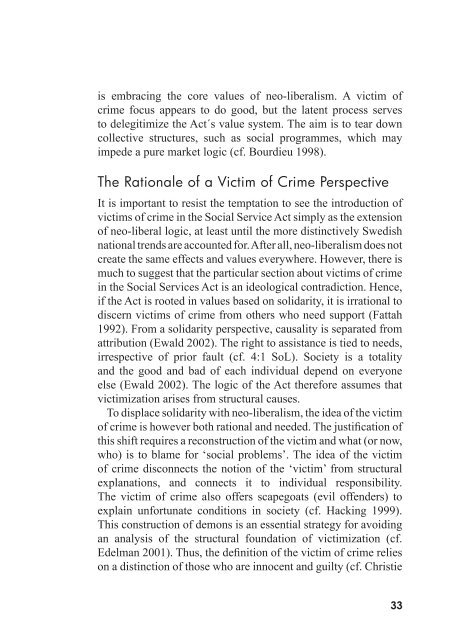Thinking with Bevereley Skeggs - Stockholms universitet
Thinking with Bevereley Skeggs - Stockholms universitet
Thinking with Bevereley Skeggs - Stockholms universitet
- No tags were found...
Create successful ePaper yourself
Turn your PDF publications into a flip-book with our unique Google optimized e-Paper software.
is embracing the core values of neo-liberalism. A victim ofcrime focus appears to do good, but the latent process servesto delegitimize the Act´s value system. The aim is to tear downcollective structures, such as social programmes, which mayimpede a pure market logic (cf. Bourdieu 1998).The Rationale of a Victim of Crime PerspectiveIt is important to resist the temptation to see the introduction ofvictims of crime in the Social Service Act simply as the extensionof neo-liberal logic, at least until the more distinctively Swedishnational trends are accounted for. After all, neo-liberalism does notcreate the same effects and values everywhere. However, there ismuch to suggest that the particular section about victims of crimein the Social Services Act is an ideological contradiction. Hence,if the Act is rooted in values based on solidarity, it is irrational todiscern victims of crime from others who need support (Fattah1992). From a solidarity perspective, causality is separated fromattribution (Ewald 2002). The right to assistance is tied to needs,irrespective of prior fault (cf. 4:1 SoL). Society is a totalityand the good and bad of each individual depend on everyoneelse (Ewald 2002). The logic of the Act therefore assumes thatvictimization arises from structural causes.To displace solidarity <strong>with</strong> neo-liberalism, the idea of the victimof crime is however both rational and needed. The justification ofthis shift requires a reconstruction of the victim and what (or now,who) is to blame for ‘social problems’. The idea of the victimof crime disconnects the notion of the ‘victim’ from structuralexplanations, and connects it to individual responsibility.The victim of crime also offers scapegoats (evil offenders) toexplain unfortunate conditions in society (cf. Hacking 1999).This construction of demons is an essential strategy for avoidingan analysis of the structural foundation of victimization (cf.Edelman 2001). Thus, the definition of the victim of crime relieson a distinction of those who are innocent and guilty (cf. Christie33
















